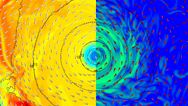Computational Physics
Since the fundamental equations of physics can in general not be solved analytically, computer simulations play a very important role in science. Simulations can be done on the atomic scale where the Schroedinger equation together with the laws of statistical physics allow in principle to describe all phenomena in solid state physics, chemistry and materials sciences. Simulations can however also be done on much larger scales to simulate for instance supernovae. Due to the rapidly increasing speed of computers, simulation is a very active field with many opportunities to improve simulation methods and with new applications becoming feasible.



